This Hawaiian Resort Used to Be an Off-grid Celebrity Haven — and It Just Reopened After 12 Years
Kona Village just reopened as a Rosewood resort with a black-sand beach and two beautiful pools. Here's what it's like to stay.
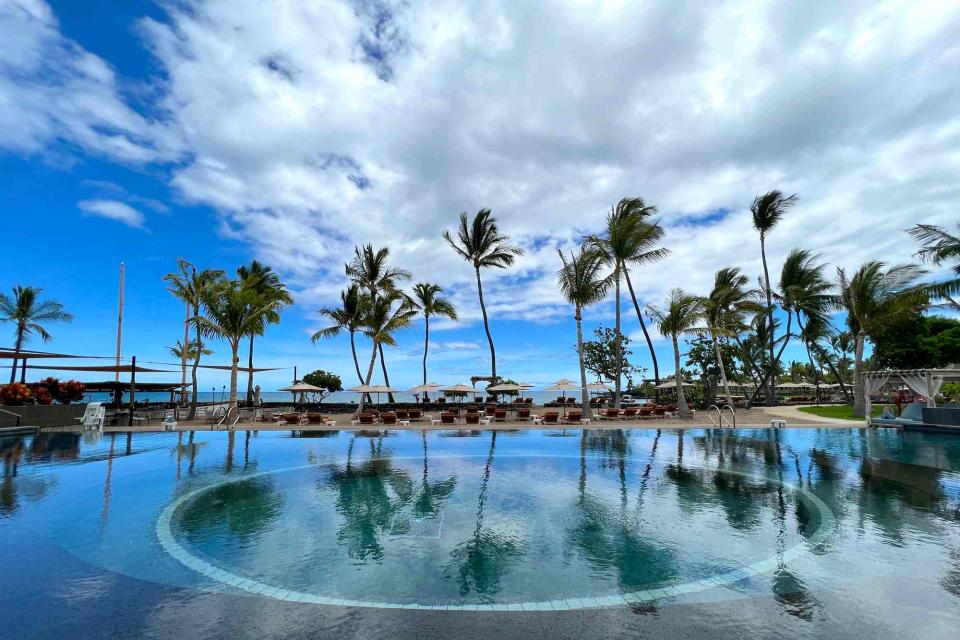
Maya Kachroo-Levine/Travel + Leisure
On Hawaii’s Big Island, there was once a resort called Kona Village. It opened in 1966, and because the closest public road was two miles away, guests took a puddle-jumper plane to the resort, piloted by whoever was around – a concierge, a cook, occasionally someone licensed to fly. The main bar was a beached sailboat called New Moon, which belonged to Kona Village’s founders, Johnno and Helen Jackson. When they were fixing up the resort, they anchored New Moon in Kahuwai Bay, where it took on water and sank — so they hauled the vessel out of the Pacific, gave it a paint job, and served mai tais from the deck.
The resort developed a star-studded cult following. Supposedly, The Doors’ Jim Morrison once set a record by drinking 21 mai tais at Shipwreck Bar. It was Steve Job’s favorite place to vacation — though, ironically, the place embraced an off-the-grid philosophy. Guests were told to leave their cell phones in the rooms, and there were no TVs. When they wanted privacy, they’d put a coconut outside the door.
Kona Village, A Rosewood Resort
There are two stunning pools and an outdoor activities center where guests can use kayaks, stand-up paddleboards, and snorkeling equipment.
On the resort's 81 acres are only 150 hale, or houses, decorated with art commissioned from mostly native Hawaiian artists.
The hotel is just 10 miles — less than a 20-minute drive, typically — from Kona International Airport.
There are four bars and restaurants, including one made from a sailboat the owners sank nearby. Equally important: there's a daily 3 p.m. coconut cart serving complimentary drinking coconuts by the pools.
Kona Village was destroyed in 2011 by an earthquake-triggered tsunami. “No one got to say goodbye,” a guest who visited every year with her family, from when she was six to 14 years old, told me. There was no closure — only wreckage and a Save Kona Village Facebook page with 8,500 followers.
On July 1, the pleas of those 8,500 die-hards were answered: Kona Village reopened as the 31st property in the Rosewood Hotels & Resorts portfolio. When my husband and I arrived eight days into Kona’s next chapter, we were some of the only guests who hadn’t been to the original resort. Most guests were Kona Village faithfuls who asked for their old rooms and couldn’t wait to tell me that Rosewood had brought back those do-not-disturb coconuts.
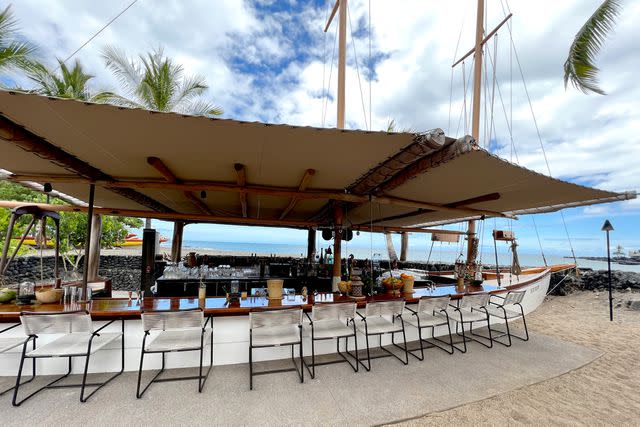
Maya Kachroo-Levine/Travel + Leisure
Rosewood brought back Shipwreck Bar, too. (Yes, the New Moon survived the tsunami — the boat’s the “only thing stronger than the drinks,” one resort friend told me.) The adjacent pool now has a sumptuous black-stone hot tub that reflects the palm trees overhead. My husband and I posted up here for coconut o’clock, a.k.a. 3 p.m., when a cart brimming with bright-green drinking coconuts comes around. Then, we whiled away our afternoon swimming the length of the 82-foot pool and lazing in our shaded cabana with octopus tostadas and a round of Conrad’s Mai Tais. (Important note: every bar and dining venue makes a different mai tai. I took a Pokemon gotta-catch-’em-all approach.) Shipwreck Bar’s mai tai is named for the resort’s OG bartender, Conrad, and rumor has it, the nearly lethal original recipe had seven-and-a-half ounces of booze. It’s now served by Conrad’s successor, Marlin Hunter — who, true story, was named for the giant marlin his father caught on this very beach. The updated cocktail may seem downright chaste by comparison, but it was still enough to send me back to my hale for a delicious nap on the shaded sectional of my 215-square-foot deck.
Here, everything you need to know about Kona Village, A Rosewood Resort.
The Rooms
Our 1,570-square-foot hale, which means house in Hawaiian, had one bedroom, a separate living room, a bathroom with a stand-alone tub, and an outdoor shower. “It feels like your own little beach house,” says Nicole Hollis, the interior designer on the project, who is also working on the Rosewood Sand Hill renovation in northern California. “We wanted it to feel Hawaiian, not be themed Hawaiian.” The hale’s exposed Douglas fir shiplap acts as a natural canvas, strewn with functional art (i.e., “things Hawaiians actually use to decorate their homes,” Hollis says), like fans, hats, paddles, and kapa-printed pillows — most made by Hawaiian artists.
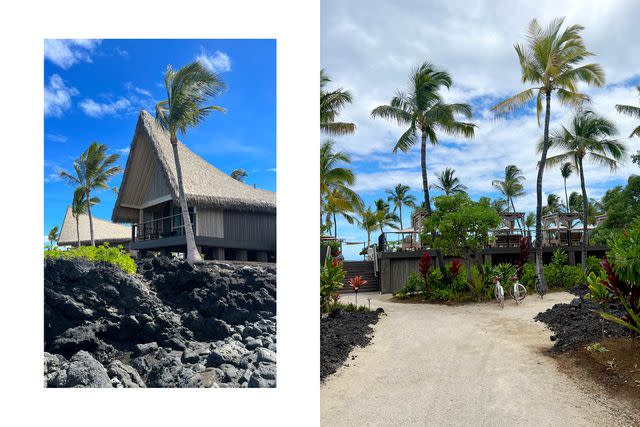
Maya Kachroo-Levine/Travel + Leisure
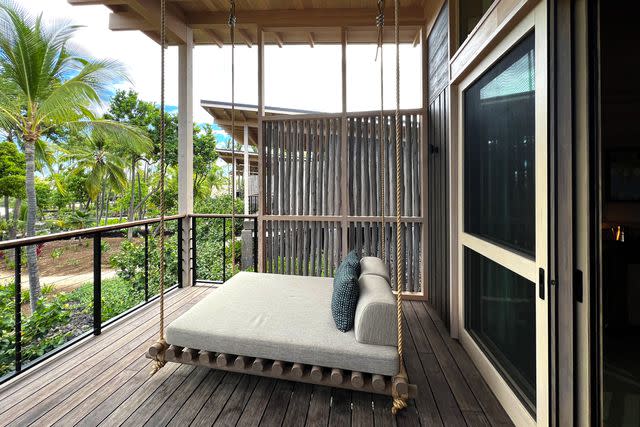
Maya Kachroo-Levine/Travel + Leisure
There are also two- and four-bedroom suites — the former has nearly 2,500 square feet of indoor and outdoor space — plus two $35,000-a-night presidential suites with private infinity pools gazing over a secluded sliver of black-sand beach. But the hottest tickets are the six legacy hale — the only ones from the original Kona Village, built in the ‘69, that survived the tsunami. I was also quite taken with the Shed hale, on an inland perch overlooking the resort’s fish ponds; they have a chic studio setup and a dreamy daybed swing on the porch that I still wake up thinking about.
Food and Drink
There are four bars and restaurants at Kona Village. Moana, the main dining room, serves unreal Hawaiian malasada donuts at breakfast. (For those following the mai tai gotta-catch-’em-all storyline, the Moana Mai Tai packs a flavorful punch with an amaro floater.) In front of Moana, where my husband and I dug into cured kampachi, grilled local prawns doused in chili oil, and fresh-caught snapper in a mushroom dashi, is Talk Story Bar. There’s also Kahuwai Cookhouse and Market, where there are wellness shots and Greenwell Farms coffee by day and fire-cooking by night; and, of course, Shipwreck Bar.
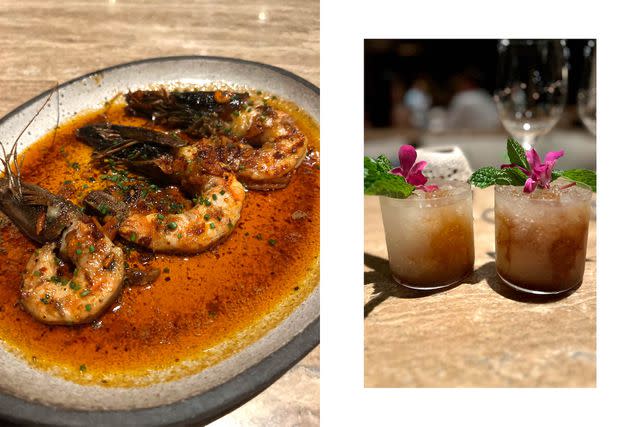
Maya Kachroo-Levine/Travel + Leisure
Finally, guests can book an alfresco “imu” dinner separately ($250 a person). “The imu was a traditional way of cooking our food in an underground oven,” explained Rolinda “Kumu Welu” Bean, the resort's cultural manager, before my husband and I joined the 11 other guests for dinner. “They would heat up the rocks, lay banana leaves and tea leaves, and then they’d put fish and whatever else they’d gathered inside.” The resort has recreated this stone-lined hearth and the communal dining experience, with modern embellishments: dinner is served at a long table beneath tea light–tangled trees. We started with salmon sashimi and a Loire Valley–sourced sparkling blanc de noir as bowls of macaroni salad — mac salad is big in Hawaii — imu-roasted sweet potatoes and shredded pork from the hearth appeared on the table. The night ended with a round of espresso martinis, made with — what else? — local Kona coffee.
Experiences and Amenities
The resort has a gym (if you’re going to work out on vacation, may as well hit the outdoor Peloton facing a field of lava rocks), a spa, two pools with hot tubs, bikes for every guest, tennis and pickleball courts, and free Wi-Fi. Guests can host events on the Hoʻokipa lawn.
I found all the best activities at Kilo Kai, which is the hotel’s ocean adventure hub. Here, guests can rent snorkeling equipment, stand-up paddleboards, and kayaks, and sign up for guided ocean canoe sessions. My husband and I spent a morning outrigger canoeing with our guide, Cam, paddling toward Maui’s Haleakalā volcano, the Big Island and Hualalai volcano behind us.
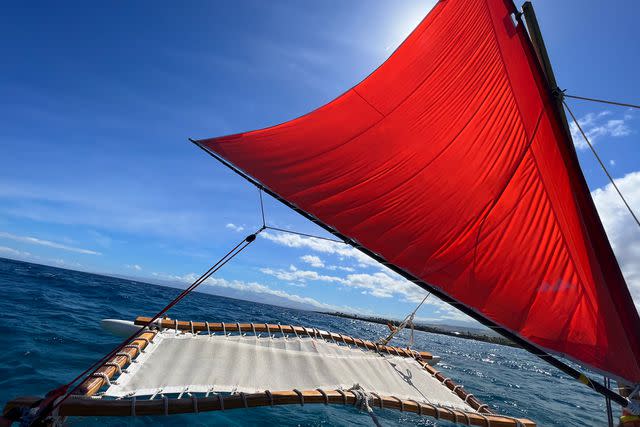
Maya Kachroo-Levine/Travel + Leisure
My favorite moments at Kona Village, however, were spent on Mike Field’s sailing canoe, Hina’ea. Field, a Rosewood ambassador who works for the hotel’s development company, built the canoe himself, attaching a massive, vibrantly red sail and two white woven “trampolines” (his words, I wouldn’t bounce on them) to the 30-foot-long vessel. Hina’ea carried us three miles out into the Pacific — Field paddling at the boat's stern, and my husband and I scrambling from one woven trampoline to the other as we tacked, watching peppy fly fish bounce out of the water, craning our necks to see dolphins. It was exhilarating enough that I tried to convince him we should keep sailing the 27 miles west to Maui. Next time, perhaps. Guests can book the sailing canoe experience with Field upon their arrival at the resort, though timing and pricing has not yet been finalized. (You may be especially tempted to book when you see Field's art around the property — he is one of 50 Hawaiian artists on display at the resort — and I would've recognized his painting of Hina’ea from a mile away.)
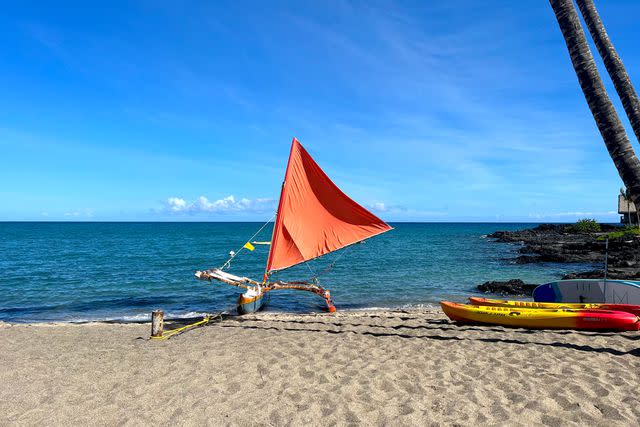
Maya Kachroo-Levine/Travel + Leisure
The Spa
At Asaya Spa, a deck connecting the welcome area to the treatment rooms is suspended over undulating black lava waves spilled from Hualalai’s 1805 eruption. In the welcome area, stocked with EviDens products, I claimed a stool at the salt-and-scent bar, where a host blended a custom scrub for my post-massage shower. Then, I settled in for a decadent 60-minute massage, my therapist kneading my back with hot lava rocks. While the treatments and products are, indeed, next-level, it’s really the setting that guarantees serenity. The open-air lounge, decked out with jute rugs and evocative copper art pieces, as well as the men’s and women’s pool and sauna areas, face expansive lava rock fields or lush green patches littered with delicate white pikake flowers. It’s very much like going to the spa in the middle of Jurassic Park.
Accessibility and Sustainability
Long before Kona Village was Steve Jobs’ favorite resort, it was a fishing village, founded by Polynesians who sailed over in the 1500s. To preserve the village's history — which is in the bones of the resort, between the 300-year-old lava flows and the petroglyph fields, where Indigenous Hawaiians carved stories into the lava — the hotel has a cultural center run by Bean. She offers tours of the petroglyph fields and routinely meets with the resort’s Cultural Advisory Board, composed of eight descendants of this land. I fished with Bean and sustainability manager Lauren Nakoa at the resort’s ponds — which is just as popular with kids as it is with adults. The goal is to clear the invasive tilapia from the water and bring in native species (think: mullet, milk fish) “to honor the culture of Indigenous Hawaiian fish ponds,” Bean said as she pulled her line up to reveal a squirming gray tilapia, its open mouth forming a perfect O.
Kona Village, A Rosewood Resort, is on its way to being the first luxury hotel in Hawaii entirely powered by solar and has the largest private collection of solar panels in the state. Of the 150 rooms on the hotel’s 81 acres, 17 are ADA compliant. In terms of getting around, the entire property is walkable (the bikes are fun, but certainly not necessary), and there are an abundance of golf carts to take guests anywhere on property.
Family-friendly Offerings
I can’t personally vouch for the kids’ programming, but I will say that being a family-friendly resort is part of this resort’s legacy. On my visit to Kona, I met travelers about my age who had grown up coming to Kona Village every summer. Kids will find plenty to do at Rosewood Explorers Keiki Club, which focuses on activities that keep sustainability and cultural appreciation top of mind. For example, kids can fish for tilapia just like I did with Bean and Nakoa, and what they catch helps feed seals that are rehabilitating at Ke Kai Ola: Monk Seal Rehabilitation Center.
The Location
The resort is on the west side of the Big Island, just 10 miles north of Kona International Airport. The resort can arrange airport transfers for guests. We arrived at the resort about 30 minutes after we walked off the plane. (How's that for a family-friendly amenity?) The closest volcano, for hiking, is Hualalai, and the town of Kailua-Kona is about 16 miles away. To explore the island, you would need to rent a car or arrange private transportation with the hotel.
Finding the Best Value
There’s no denying that the price of admission at Kona Village is steep. Rooms start at $2,500 a night. That said, all signature suites come with an inclusive package, including daily breakfast at Moana, laundry, airport transfers, spa treatments for two adults, in-room dining, and a host of other personalized amenities. While Rosewood does not have a loyalty program, the resort is already part of American Express Fine Hotels & Resorts, which means, if you book with an Amex platinum card, you get early check-in, late check-out, room upgrades based on availability, breakfast, and a $100 experience credit.
For more Travel & Leisure news, make sure to sign up for our newsletter!
Read the original article on Travel & Leisure.

